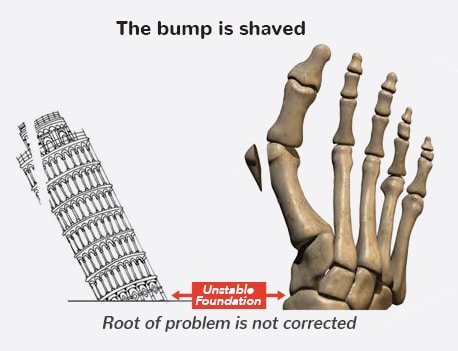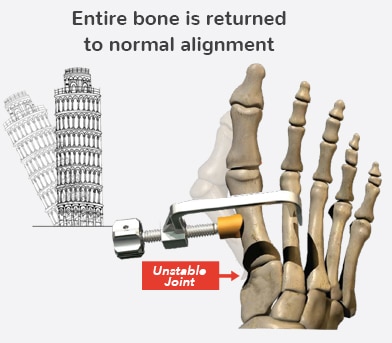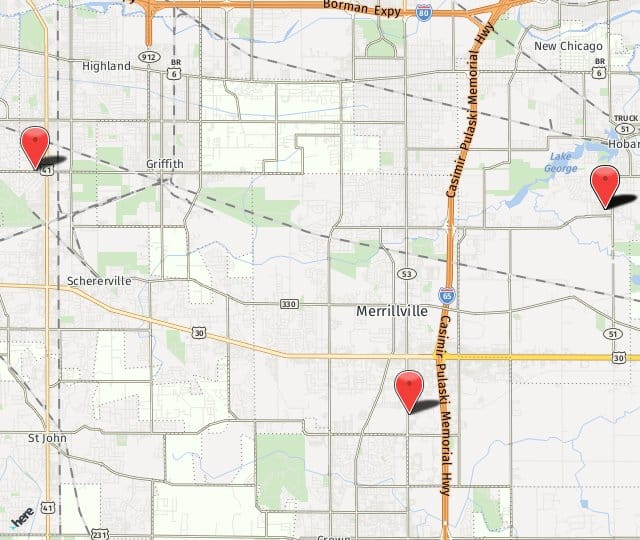Convenient Locations in Highland, Hobart, & Merrillville
Are Bunions Limiting Your Activities and Lifestyle?
Bunions can be very painful. With each step, your entire body weight rests on that bunion. Ouch! A common misconception about a bunion is that it is an overgrowth of bone that can simply be “shaved off”. In reality, bunions are complex deformities caused by an unstable joint.
Lapiplasty® 3d Bunion Correction
Relief is here. Now, there’s a new, patented treatment for bunion correction – Lapiplasty® 3D Bunion Correction. We are offering a new treatment option which does more than simply remove “the bump”; it addresses your bunion in three dimensions to correct the root of the problem. Advanced fixation technology is used to secure the correction in place, allowing patients to walk within days of surgery.
Why Was Lapiplasty® 3d Bunion Correction Developed?
For 87% of people with bunions, traditional surgery has failed to get to the true source of the problem – a 3-dimensional deformity caused by an unstable joint.This is why many people who have had traditional surgery have had their bunions return. In fact, 1 in 3 patients have been left dissatisfied with their surgical outcome in the past and up to 70% of those treated have had their bunion return.
Traditional Surgery is a 2d Solution for a 3d Problem
Traditional bunion surgery has been limited to an incomplete, two-dimensional (2D) approach to correction; cutting the bone in half and pushing the top part over to reduce the appearance of the bump. This 2D “cut and shift” approach primarily addresses the bunion’s symptoms, not the root cause – the unstable foundational joint – leaving the bunion significantly more likely to come back to some degree.

How Does Lapiplasty® 3d Bunion Correction™ Work?
Instead of cutting the bone in half and shifting the top part over, the patented Lapiplasty® Procedure uses specially-designed instrumentation to rotate the entire deviated bone back into its normal anatomical position, naturally straightening your toe; removing the “bump” and associated pain. Innovative titanium plating technology 5,6 permanently secures the unstable foundation, the root of your bunion problem. Most patients are able to walk within days of surgery. No cast is required; allowing patients to get back to the shoe wear of their choice and activities quickly.

What Are the Symptoms of a Bunion?
Bunions are pretty obvious when they form. This is what to look for or expect:
- A bulging bump on the outside of the base of your big toe
- Swelling, redness, or soreness around the big toe joint
- Corns or calluses where the first and second toe overlap
- Persistent or intermittent pain
- Restricted movement if arthritis is involved
What Are the Common Causes of Bunions?
Why some people develop bunions while others don’t is somewhat of a mystery. It is thought that these factors play a part:
- Inherited foot anatomy
- Foot injuries
- Deformities from birth (congenital)
Most people who develop bunions have a physical propensity to do so. They were born with the chance of getting a bunion because of deformity in the middle of the foot.
It would seem that wearing tight, narrow, high-heeled shoes would have a direct correlation, but research hasn’t shown a clear cause and effect. If these types of shoes don’t cause the condition that allows a bunion to form, they contribute to their development.
Bunions may also be associated with inflammatory types of arthritis, such as rheumatoid arthritis.
Can I Have Lapiplasty Performed on Both Feet at the Same Time?
With the current state of our healthcare system where patients hit deductible thresholds in their plans before their out-of-pocket amounts drop dramatically, many patients hit their deductible number and then seek to take care of another procedure within the same calendar year. This can be true with bunions and Lapiplasty® procedures; patients want to have both feet surgically repaired at the same time.
While this is possible, thanks to the shorter recovery necessary with Lapiplasty®, we still don’t recommend this. After all, patients still need to be in a walking boot for the first 6-8 weeks after their Lapiplasty® at Bone & Joint Specialists. While that is a far better option than crutches with traditional bunion surgery, it still isn’t normal walking. Having a walking boot on both feet isn’t very practical for most patients.
A better bet would be to wait at least that first 6- to 8-week period before having the second foot operated on. Even a few weeks longer than that would be preferrable.
What Do I Need to Do to Prepare for Lapiplasty?
This is general surgery, so you’ll need to prepare as you would for any surgery. You’ll stop taking any blood thinning medication, aspirin, anti-inflammatories, and most herbal supplements for a few days before your procedure. These can all lead to excessive bleeding. If you smoke, you’ll need to stop for at least two weeks prior to and following your Lapiplasty® because smoking constricts the blood vessels, which impedes healing.
While these recoveries are far easier than with other bunionectomy procedures, you will still need downtime. You’ll want to prepare a recovery nest, complete with all the entertainment options your need and pillows and pads necessary to elevate your leg and for icing. After the first day, you’ll be in a walking boot, and this allows you to get around, but it’s not as if you’ll be moving normally. You’ll want to have someone around to take care of needed chores or childcare. It’s a good idea to cook some meals beforehand and freeze them. You’ll also need to make preparations at work. Most of our patients working a desk job can return to work in from 5 to 14 days. That variation is based on the individual and how they feel. If your job involves labor or being on your feet for prolonged periods you’ll need more time, possibly 4 to 6 weeks.
Will I Be Able to Bend My Big Toe after Lapiplasty?
Yes, you will still have normal movement of your big toe after this surgery at Bone & Joint Specialists. The fusion in this procedure takes place at the metatarsophalangeal joint. This is deemed to be more of a “non-essential” joint. The majority of motion in the big toe is preserved and often enhanced by the corrections made with Lapiplasty®.
When Can I Exercise after Lapiplasty Bunion Treatment?
During your consultation, your doctor will discuss their anticipated results and downtime with you. Recovery time can vary based on a number of factors, such as age, activity level, general health, and the degree of joint displacement at the time of surgery. Generally, we see patients regain the ability to engage in some types of exercise about two weeks after their procedures. This, of course, comes with some limitations.
Two weeks after your Lapiplasty procedure, your doctor may clear you for upper body and core exercises. You cannot put pressure on your foot and will wear a special boot for up to six weeks. After that time, when you return to wearing normal shoes, you can begin very light, low-impact activity. Your doctor may recommend that you begin resuming exercise in a pool. You can also very carefully exercise on a rowing machine or stationary bike and may be cleared to perform certain no-weight-bearing exercises like extensions and leg curls. You may be advised to refrain from full-impact exercise until 12 weeks post-op.
Will I be able to Do All the Same Activities after I Recover?
Once you are fully recovered from your 3D bunion correction, you should have no difficulty gradually returning to your previous activity level without limitation. It's even possible for some women who've had Lapiplasty to wear heels that were previously off-limits to them!
I've Had Bunion Surgery and it Didn't Work. Can I Still be a Candidate for Lapiplasty?
Having bunion surgery is a big deal. It's frustrating to encounter persistent issues. If you're still struggling with pain and physical limitations caused by bunions, you may be a good candidate for the Lapiplasty procedure. Your doctor will perform a thorough examination, possibly with imaging, to ensure that you have not developed arthritis in the great toe joint, the one affected by the bunion. This is the primary reason why some patients aren't the best candidates for 3D bunion correction.
What is the Right Age for Lapiplasty?
The Lapiplasty procedure is approved for patients aged 12 and older. That said, it is necessary for the growth plates to have closed for the treatment to be successful. This may not occur until age 14. As long as the growth plates have closed, the primary factors that your doctor will consider are your overall health and whether or not arthritis has developed in the affected joint.
You Insert Metal Screws and Plates. Could I have an Allergic Reaction to Them?
The Lapiplasty procedure involves the placement of titanium plates and screws to fully restore the affected joint. Titanium medical implants have been the norm for many years. This material is the most biocompatible available at this time. It contains a very low amount of nickel, the metal that is most likely to cause allergic reactions. The quantity of nickel present in titanium is so low that allergic reactions are very rare.
Will I Need to Have Lapiplasty Done Again in the Future?
Recurrence of the bunion has been one of the biggest problems with traditional bunion surgery, where about 70 percent of the altered bunions reform.
The Lapiplasty® was designed with the intention of preventing recurrence. This surgical method hasn’t been around that long, but data at this point shows a recurrence rate of only about 3 percent after 13 months.
Lapiplasty® Patented Titanium Plating Technology — Enabling Early Weight Bearing
The Lapiplasty® Procedure utilizes two low-profile (petite), anatomically-shaped titanium plates to permanently secure the unstable foundation of your corrected bunion. This provides buttressing on multiple planes and allows you to walk within days of surgery. Think of this in terms of how a basketball player might hold a basketball. When a player tightly grips the ball with both hands, the ball is held more securely than if only one hand is used.
Unlike other surgical approaches, the Lapiplasty® Procedure utilizes two plates for this very reason – “Two plates are better than one”.
What Should I Expect in Terms of Recovery?
The patented titanium plating technology used with the Lapiplasty® Procedure enables patients to bear weight on their foot early. The ability to do so can dramatically improve your recovery process, allowing you to walk up to 6-8 weeks earlier than with the more traditional Lapidus approach (which was previously the only option for addressing the unstable joint).
Being able to walk in a surgical boot, as opposed to being completely non-weight bearing (in a cast with scooter or crutches) for 6-8 weeks, means that you will be getting back to a better quality of life faster; may return to most occupations more quickly; and will be less inconvenienced by bunion surgery.

